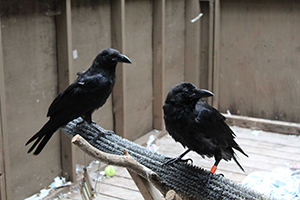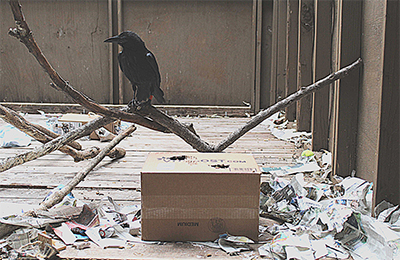A Raven’s Journey to Recovery
By Cambria Wells, Wildlife Technician Supervisor
Wildlife rehabilitation is often a story of collaboration. This is even more true when a species requires intensive or specialized care. California Wildlife Center (CWC) has a large service area and is the only facility in Los Angeles County permitted to rehabilitate Ravens and Crows, and therefore receives relatively high numbers of them each year. For that reason other wildlife rehabilitators will sometimes transfer young corvids, the family name encompassing Crows, Ravens, Jays, and Magpies, to join our groups of fledglings as a measure to prevent them becoming habituated to human care. One of these birds has been a favorite patient of CWC staff and volunteers this summer. Originally found in a rural area in Central California, Common Raven 21-2166 was treated for a fracture of his tibiotarsus, a leg bone. Once stable enough to travel, he hitched a ride with transporters to his destination here at our facility for long term care.

Common Raven 21-2166 with his “buddy”
Photo by Cambria Wells
Since 21-2166 was already an older bird and at risk of habituation to human care, staff paired him as quickly as possible with other Raven “buddies.” Then, the group was set aside in a smaller enclosure for evaluation in order to ensure they would be self-feeding and free of parasites before getting access to a large flight pen. 21-2166 quickly became known for his sweet habit of asking for food like a younger bird, not for himself, but to feed to his new friends. This highly affectionate and social Raven thrived in the presence of his own species, allowing us to provide care while keeping his behaviors closer to that of a bird being raised in a wild setting.
In the wild, corvids like Common Ravens and American Crows spend their days in activity foraging for food, engaging in complex social behaviors with their family group, and interacting with other species. They are known to raid nests, scavenge for carrion, craft and use tools, and even steal food from other foraging animals in order to survive. 21-2166 and his “buddy” were provided large numbers of objects to investigate, manipulate, and destroy to ensure they would focus on enrichment and learn skills for survival.

Common Raven 21-2166 admiring his destroyed box
Photo by Cambria Wells
Staff at CWC gives every animal, whether a new intake or a transfer, a full exam on arrival and regular checkups. This is critically important as sometimes new health issues develop in captivity. Raven 21-2166 required extensive care. Before his arrival at CWC and during transfer, he once again fractured his left tibiotarsus. During treatment for that left leg, his habit of leaning on his right led him to develop an early case of “bumblefoot,” a form of dermatitis common in birds on perching of the wrong size, which left a wound in the middle of his other foot. By the end of his visit, this Common Raven received not so common care including almost the full range of what CWC can provide; radiographs under sedation, cage rest, pain medication, antibiotics, treatment for gastrointestinal parasites, anesthetized wound care, bandage changes, small aviary residence, large flight pen residence, hand-feeding, daily enrichment, re-wilding and more! If this care were provided in isolation to such a young animal, 21-2166 likely would have been unable to be returned to the wild due to his attachment to humans. At CWC, our summer group of young Ravens means we can avoid that unhappy ending and aim for the best outcome.
Providing the medical and husbandry care to get these animals prepared for release is only possible due to the efforts of a large staff and volunteer force whose absolute focus is the return of birds like 21-2166 to their native habitat. Any juvenile Common Ravens and American Crows admitted to CWC are raised by the Orphan Care Unit. As early as 7:30 in the morning we begin their hand-feeding every 45 minutes, and feed until the sun sets in the evening, a total of around 12 hours of feeding. Nestling birds are kept incubated under close observation in the Orphan Care Unit main room until fully feathered. At this point, in order to provide the best environment for them to grow, they are moved up to a special room set aside just for Crows and Ravens. By release, our young corvids have received up to five months of daily attention from veterinary staff, and devoted husbandry care totaling about 2,500 hours of volunteer time. Corvids make up a heavy proportion of our most involved cases, most satisfying releases, and some of the dearest patients to our hearts.
